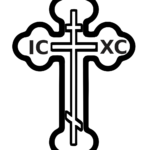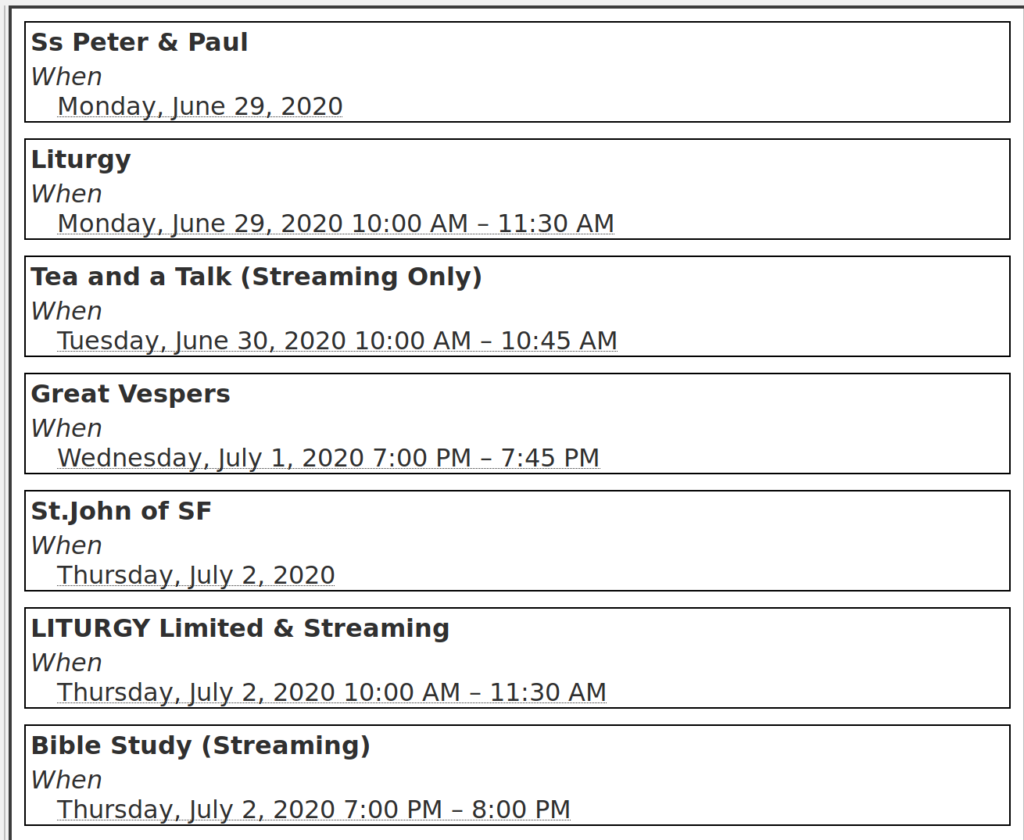
Focus on the Faith: New Year Looks to Theophany
The New Year is upon us. Let us rejoice and be glad that 2020 is behind us!
On the first week of January we have three celebrations: The Circumcision of Christ, St. Basil the Great, and the Sunday before Theophany. In the ancient church, Theophany was regarded as more important than Christ’s Nativity. How can that be? Because at Christ’s birth the announcement is made of God’s coming into the world for it’s restoration. At Theophany, that work of restoration actually begins!
It’s a New Year, and that means a new start, a new beginning in spiritual efforts! Everything about the New Year points to Theophany. It’s about Christ’s Baptism, but it’s also about ours. It’s about the renewal of Creation as Christ steps into the water, and it’s about our renewal as we step into the water either of our own baptism (catechumens, rejoice!) or as we wash ourselves with the sacramental cleansing of our own tears in Holy Confession.
Not long ago someone asked me about the blessing of homes at Theophany. They wanted to know why we do it? Does it have to be done? I explained it to them like this. I asked them about their recent trip to Constantinople. What were their impressions? They said that it made them very happy, but at the same time very sad. Here She was, the Queen of Cities, the City of the Virgin Mary, beautiful, exotic and dazzling. Yet there was something very wrong, very “off.” She was a Queen but in chains, royal yet wearing rags, noble but crushed in her humiliation, high-born, but now brought low. I said, that this was exactly my impression. I said, “you know, this world, this creation, is in captivity, not just Constantinople; it is enemy-held territory. The evil one, having enslaved all of creation at the fall, has laid claim to every nook and cranny of this earth. And for a while it looked as though he might be able to hold onto it. But then he reached too far and attempted to enslave the Master of All and to bind Life with the chains of death, and his power was broken. But creation is still fallen, still contested land.
St. Paul has written: “For the creation waits with eager longing for the revealing of the sons of God; for the creation was subjected to futility, not of its own will but by the will of him who subjected it in hope; because the creation itself will be set free from its bondage to decay and obtain the glorious liberty of the children of God. We know that the whole creation has been groaning in travail together until now; and not only the creation, but we ourselves, who have the first fruits of the Spirit, groan inwardly as we wait for adoption as sons, the redemption of our bodies.” (Romans 8: 19-23.)
We, as Christians, are engaged in this struggle as co-workers with God, to reclaim the fallen world and fallen nature for the Kingdom. We often talk about this in terms of our own salvation, but the Church, addressing all of creation in a holistic manner, also reaches out and reclaims a bit here and a bit there of creation in general. We do this in order that we might restore the usefulness of creation for working out our own salvation. Hence we bless anything that might help us in our salvation – and by blessing it we reclaim it for the Kingdom of God. We bless water, we bless grapes and fruit, we bless cheese, eggs, meat, we bless wheat wine and oil, we bless all kinds of things, reclaiming them for sacred use, reclaiming them for God’s Kingdom.
There are few things more vital to our lives than our homes. In our homes we pray, we work, we rest, we sleep, we converse with loved ones, we order our lives, we work out our marriages, raise our children, etc. Is there a more important place for us to reclaim for the Kingdom of God ?- or is it better to continue living in a place which is occupied and influenced by the enemy? For the most effective working out of our salvation, we should drive the enemy out of our homes, and keep him at bay by our prayers, our righteous life, and the annual sprinkling by Holy Water at Theophany. Hence this annual and salutary rite of the blessing of homes at Theophany.”
From the Fathers
Sermon on Theophany by St John, Archbishop of Shanghai and San Francisco the Wonder-Worker
In the Name of the Father and the Son and the Holy Spirit.
As we celebrate Theophany, we remember how God revealed himself as the Trinity, that Jesus appeared to the people as Christ. Where did Christ appear Hos did He begin His mission? Did He enter a great city and reveal Himself in His glory? Did He ascend a great mountain as many thousands of people beheld Him from below, wondering at the miracle? No! Christ went into the wilderness, to the Jordan River, where John was baptizing the people. John preached repentance, and called upon sinners, in a sign of repentance, to be baptized in the Jordan. And it was as a sinner that Christ came and asked for baptism. Yet He had no sin. John was afraid: “I have need to be baptized of thee, and comest thou to me? And Jesus answering said unto him, suffer it to be so now: for thus it becometh us to fulfil all righteousness” (Matthew 3:15). Adam sinned through pride, he wished to elevate himself, to become like God. But Christ cam to fulfill the truth of God, to correct Adam’s pride through humility. Christ entered the water and received baptism from His servant. Trembling, John placed his hand upon his God and Master, and Christ humbly bowed His head. Christ’s humility opened up the heavens, and the voice of God the Father boomed forth: “This is my beloved Son, in whom I am well pleased” (Matthew 3:17). This is My Son, Who humbled Himself in order to fulfill My will, My true Son, Who humbles Himself in order to elevate mankind. Christ’s meekness opened the heavens and revealed to mankind the Trinitarian nature of God.
But why did He do this in water, and not someplace else? Let us remember how God created the universe. When God created the heavens and the earth, “the earth was without form, and void; and darkness was upon the face of the deep” (Genesis 1:2). God then divided the firmament and the waters, but water remained everywhere, for it is required for all life. Man cannot live without water, nor can any creature; there is water (moisture) in the air; every handful of earth contains water; there is water in rock, even though we cannot see it, and when God wishes, water emerges from it, as it did with Moses. “The earth is the LORD’S, and the fulness thereof; the world, and they that dwell therein. For he hath founded it upon the seas, and established it upon the floods” (Psalms 24:1-2). “For this they willingly are ignorant of, that by the word of God the heavens were of old, and the earth standing out of the water and in the water: Whereby the world that then was, being overflowed with water, perished (2 Peter 3:5-6).
When man sinned, he provoked God’s wrath not only upon himself but upon all of nature. Man is the crown of God’s Creation; he was given dominion over nature. When the king—mankind—became the enemy of the King Himself, his kingdom became the kingdom of the enemy. Punishment was brought down not only upon mankind, but upon nature as well. We know that “the whole creation groaneth and travaileth in pain together until now” (Romans 8:22). But creation submitted to chaos not willingly, “but by reason of him who hath subjected the same in hope” (Romans 8:20). For this reason, the forgiveness of the guilty will emancipate all of creation from servitude to death. This mortal nature will end and it will be transformed to a new heaven and a new earth, “wherein dwelleth righteousness” (2 Peter 3:12-13). In order to facilitate this transformation, to prepare nature for immortality, which will take place after the Terrible Day of Judgment, Christ came into the waters of the Jordan.
Immersing Himself in the Jordan River, Christ not only sanctified the waters of the Jordan, but the very nature of water, as the Church exclaims in song: “Christ appeared in the Jordan to sanctify its waters” (troparion on Theophany Eve). And since water is found everywhere, then by sanctifying the water, Christ sanctified all of Creation, the entire universe. Christ prepared all of nature to experience the blessed consequence of sacrifice which He came to offer. But this is not all. He gave water the power to wash away the sin of mankind. Christian baptism is rebirth, forgiveness of all sins. With water, God punished the sins of early man and destroyed mankind in the Flood. Now, with water, God saves mankind in the Mystery of Baptism.
And so Christ crushed the head of the serpent in the waters of the Jordan, as we sing in church, the serpent which had deceived Adam and Eve, but was vanquished with the humility of Jesus; He revealed to mankind that God is Trinity, He sanctified the water, and through water He sanctified all of creation, preparing it to receive the words of forgiveness and immortality. And holding another victory over the devil in the wilderness, Christ went to prepare mankind for His future Kingdom, and began His ministry with the words: “Repent: for the kingdom of heaven is at hand” (Matthew 4:17), or, as the Gospel also says: “The time is fulfilled, and the kingdom of God is at hand: repent ye, and believe the gospel” (Mark 1:15).
Until then, John the Baptist preached repentance, preparing the path for the Lord. Now the Lord Himself exclaims “Repent!” This word is addressed not only to those who lived in the time of Christ, but to all people in all places and ages. We hear this word in the Gospel. Even before the days of celebrating Theophany are over, the word reminds us that the time for repentance is near.
Let us be attentive! These are not the words of a prophet or an angel, but of the Lord Himself. Let us repent, and as Lent approaches, let us try to defeat our passions and receive forgiveness for our sins, so that we may spend eternity in the immortal Kingdom which the Lord has prepared for us. Amen!
Bitola, Serbia, 1928.
Lives of the Saints
January 1 – The Circumcision of Our Lord Jesus Christ
In keeping with the Law of Moses, the Savior’s parents had Him circumcised eight days after His birth (see Luke ch. 2). On this day, following Jewish custom, he received the name Jesus (Yeshua, a form of Joshua), meaning “God saves.” Thus, on this day, the Covenant of Moses was fulfilled and brought to an end, and the Salvation of God’s people was proclaimed to the world.
Our Father among the Saints Basil the Great (379).
In its services, the Church calls St Basil a “bee of the Church of Christ”: bringing the honey of divinely-inspired wisdom to the faithful, stinging the uprisings of heresy. He was born in Cappadocia to a wealthy and prominent family. Their worldly wealth, however, is as nothing compared to the wealth of Saints that they have given to the Church: his parents St Basil the Elder and St Emmelia; his sister St Macrina (July 19), the spiritual head of the family; and his brothers St Gregory of Nyssa (January 10), and St Peter, future bishop of Sebaste (January 9).
Inspired and tutored by his father, a renowned professor of rhetoric, the brilliant Basil set out to master the secular learning and arts of his day, traveling to Athens, where he studied alongside his life-long friend St Gregory of Nazianzus. When he returned from his studies in 356, he found that his mother and his sister Macrina had turned the family home into a convent, and that his brothers had also taken up the monastic life nearby. Puffed up by his secular accomplishments, he at first resisted his sister’s pleas to take up a life devoted to God, but at last, through her prayers and admonition, entered upon the ascetical life.
After traveling among the monks of Egypt, Palestine and Syria, he settled in Cappadocia as a hermit, living in utter poverty and writing his ascetical homilies. A monastic community steadily gathered around him, and for its good order St Basil wrote his Rule, which is regarded as the charter of monasticism. (St Benedict in the West was familiar with this Rule, and his own is modeled on it.)
In about 370 he was consecrated Bishop of Caesarea in Cappadocia. Even as bishop, he continued to live without any possessions save a worn garment to cover himself. At this time the Arian heresy was rending the Church, and it became St Basil’s lot to defend Orthodoxy in Sermons and writings, a task which he fulfilled with such erudition and wisdom that he is called “Basil the Great.” He reposed in peace in 379, at the age of forty-nine.
St Gregory, Bishop of Nazianzus (374), father of St Gregory the Theologian
He converted to Christianity from paganism as an adult through the influence of his pious wife St Nonna (Aug. 5). He was made Bishop of Nazianzus in Cappadocia in 329, and served faithfully for forty-five years, defending his flock against the inroads of Arianism and the persecutions of Julian the Apostate. Late in life, he ordained his son Gregory, later known as St Gregory the Theologian (Jan. 25) to assist him. He reposed in peace, aged almost 100.
In about 370 he was consecrated Bishop of Caesarea in Cappadocia. Even as bishop, he continued to live without any possessions save a worn garment to cover himself. At this time the Arian heresy was rending the Church, and it became St Basil’s lot to defend Orthodoxy in Sermons and writings, a task which he fulfilled with such erudition and wisdom that he is called “Basil the Great.” He reposed in peace in 379, at the age of forty-nine.
January 2 – St Seraphim of Sarov (1833)
“Saint Seraphim was born in the town of Kursk in 1759. From tender childhood he was under the protection of the most holy Mother of God, who, when he was nine years old, appeared to him in a vision, and through her icon of Kursk, healed him from a grave sickness from which he had not been expected to recover. At the age of nineteen he entered the monastery of Sarov, where he amazed all with his obedience, his lofty asceticism, and his great humility. In 1780 the Saint was stricken with a sickness which he manfully endured for three years, until our Lady the Theotokos healed him, appearing to him with the Apostles Peter and John. He was tonsured a monk in 1786, being named for the holy Hieromartyr Seraphim, Bishop of Phanarion (Dec. 4), and was ordained deacon a year later. In his unquenchable love for God, he continually added labours to labours, increasing in virtue and prayer with titan strides. Once, during the Divine Liturgy of Holy and Great Thursday he was counted worthy of a vision of our Lord Jesus Christ, Who appeared encompassed by the heavenly hosts. After this dread vision, he gave himself over to greater labours.
“In 1794, Saint Seraphim took up the solitary life in a cell in the forest. This period of extreme asceticism lasted some fifteen years, until 1810. It was at this time that he took upon himself one of the greatest feats of his life. Assailed with despondency and a storm of contrary thoughts raised by the enemy of our salvation, the Saint passed a thousand nights on a rock, continuing in prayer until God gave him complete victory over the enemy. On another occasion, he was assaulted by robbers, who broke his chest and his head with their blows, leaving him almost dead. Here again, he began to recover after an appearance of the most Holy Theotokos, who came to him with the Apostles Peter and John, and pointing to Saint Seraphim, uttered these awesome words, ‘This is one of my kind.’
“In 1810, at the age of fifty, weakened by his more than human struggles, Saint Seraphim returned to the monastery for the third part of his ascetical labours, in which he lived as a recluse, until 1825. For the first five years of his reclusion, he spoke to no one at all, and little is known of this period. After five years, he began receiving visitors little by little, giving counsel and consolation to ailing souls. In 1825, the most holy Theotokos appeared to the Saint and revealed to him that it was pleasing to God that he fully end his reclusion; from this time the number of people who came to see him grew daily. It was also at the command of the holy Virgin that he undertook the spiritual direction of the Diveyevo Convent. He healed bodily ailments, foretold things to come, brought hardened sinners to repentance, and saw clearly the secrets of the heart of those who came to him. Through his utter humility and childlike simplicity, his unrivalled ascetical travails, and his angel-like love for God, he ascended to the holiness and greatness of the ancient God-bearing Fathers and became, like Anthony for Egypt, the physician for the whole Russian land. In all, the most holy Theotokos appeared to him twelve times in his life. The last was on Annunciation, 1831, to announce to him that he would soon enter into his rest. She appeared to him accompanied by twelve virgins martyrs and monastic saints with Saint John the Baptist and Saint John the Theologian. With a body ailing and broken from innumerable hardships, and an unspotted soul shining with the light of Heaven, the Saint lived less than two years after this, falling asleep in peace on January 2, 1833, chanting Paschal hymns. On the night of his repose, the righteous Philaret of the Glinsk Hermitage beheld his soul ascending to Heaven in light. Because of the universal testimony to the singular holiness of his life, and the seas of miracles that he performed both in life and after death, his veneration quickly spread beyond the boundaries of the Russian Empire to every corner of the earth.
Upcoming Events
Upcoming events this month (Events are subject to change! see the online calendar for updates or the attached PDF for more info)


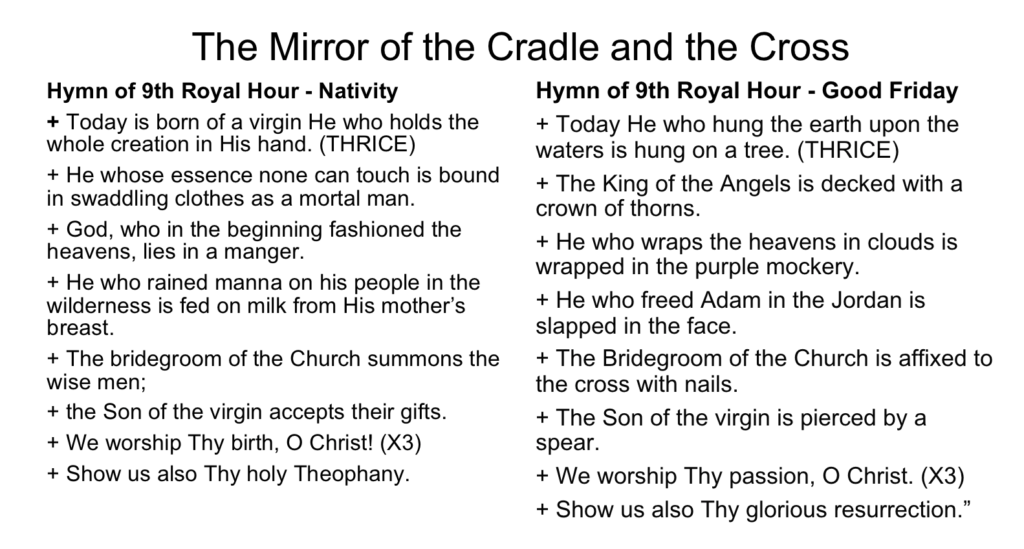


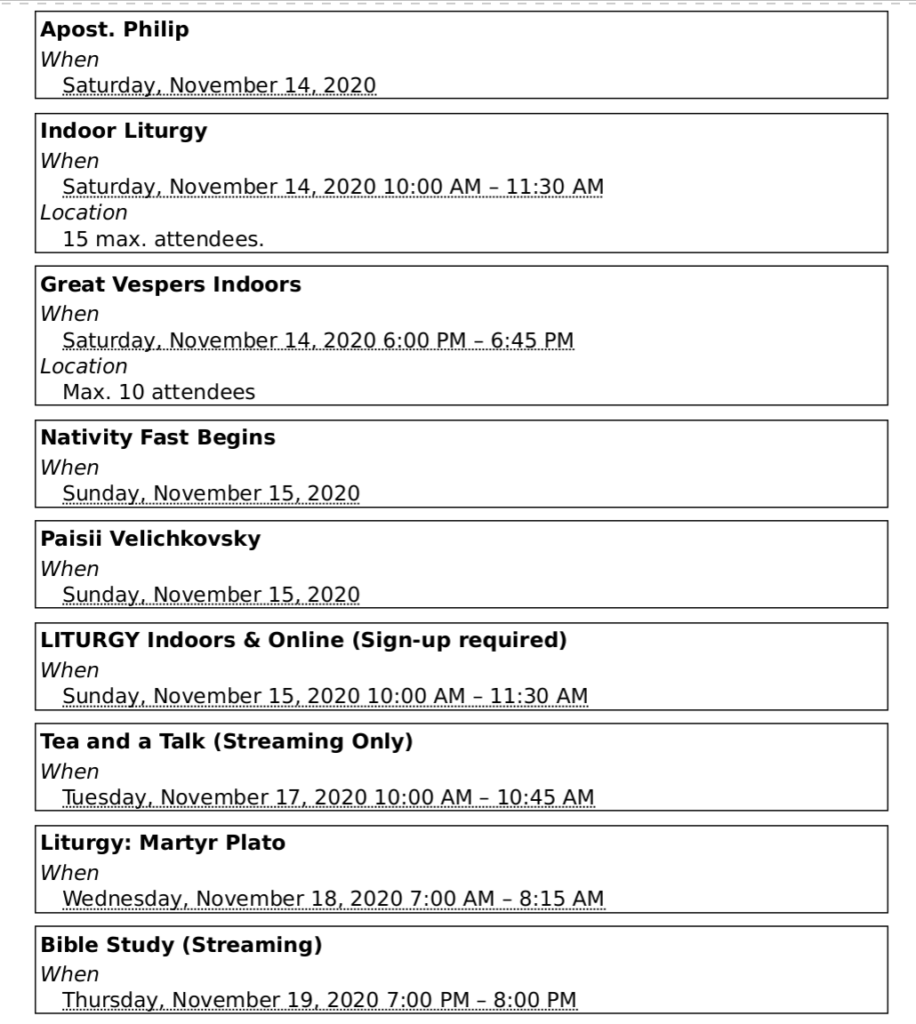
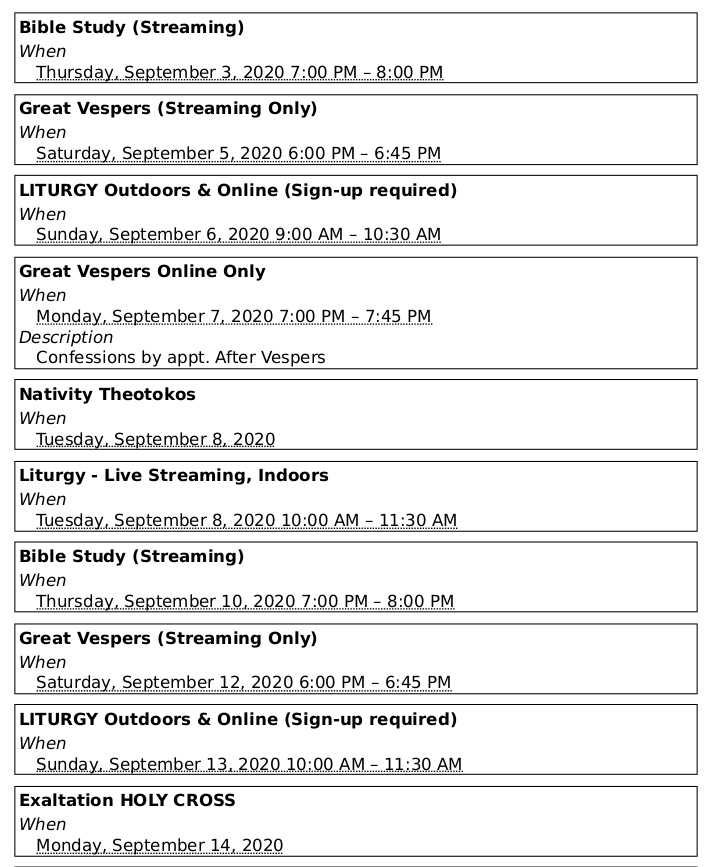
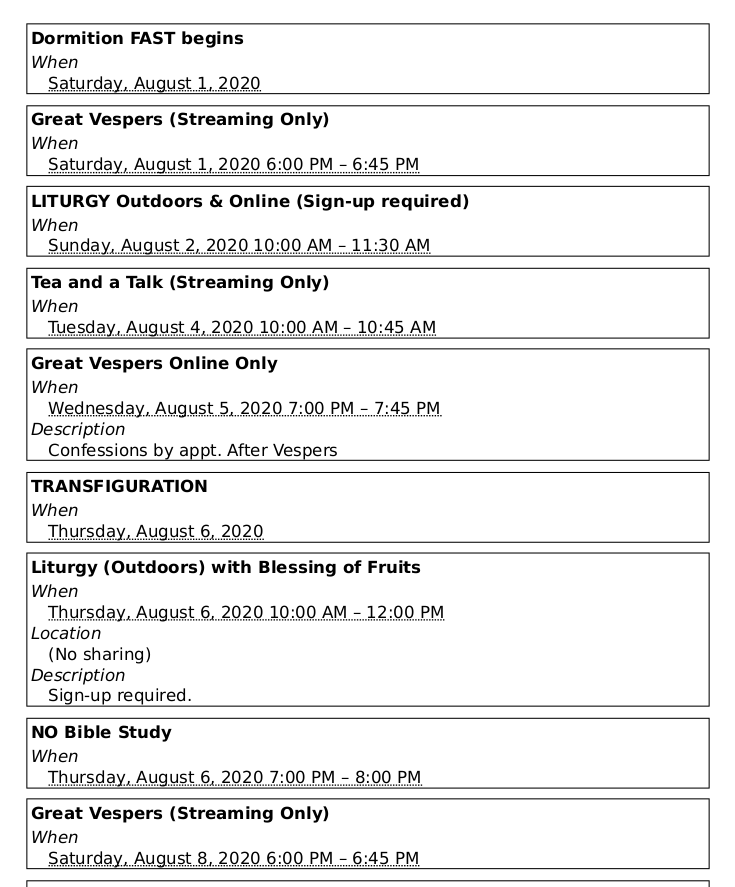
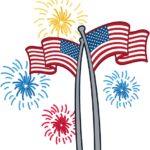 The Fourth of July is always a time for celebration in our land. It is a chance for family and friends to gather together for barbeques, outdoor activities, and fireworks. It is common practice in our churches to offer a Prayer Service, a Molieben of Thanksgiving at this time, and here, in the Pacific Central Deanery, it has been the custom for nearly 100 years to make a pilgrimage to Fort Ross and offer the Divine Liturgy there at the chapel in thanksgiving to God for this wonderful country of ours. But this year will be an exception. There will be NO Liturgy on the 4th of July at the Fort! COVID19 has seen to it that our get-togethers, fully open divine services, and pilgrimages are out! What a disappointment. But we can still take time out from our holiday to focus more carefully on the deeper meaning of the “Glorious Fourth.”
The Fourth of July is always a time for celebration in our land. It is a chance for family and friends to gather together for barbeques, outdoor activities, and fireworks. It is common practice in our churches to offer a Prayer Service, a Molieben of Thanksgiving at this time, and here, in the Pacific Central Deanery, it has been the custom for nearly 100 years to make a pilgrimage to Fort Ross and offer the Divine Liturgy there at the chapel in thanksgiving to God for this wonderful country of ours. But this year will be an exception. There will be NO Liturgy on the 4th of July at the Fort! COVID19 has seen to it that our get-togethers, fully open divine services, and pilgrimages are out! What a disappointment. But we can still take time out from our holiday to focus more carefully on the deeper meaning of the “Glorious Fourth.”